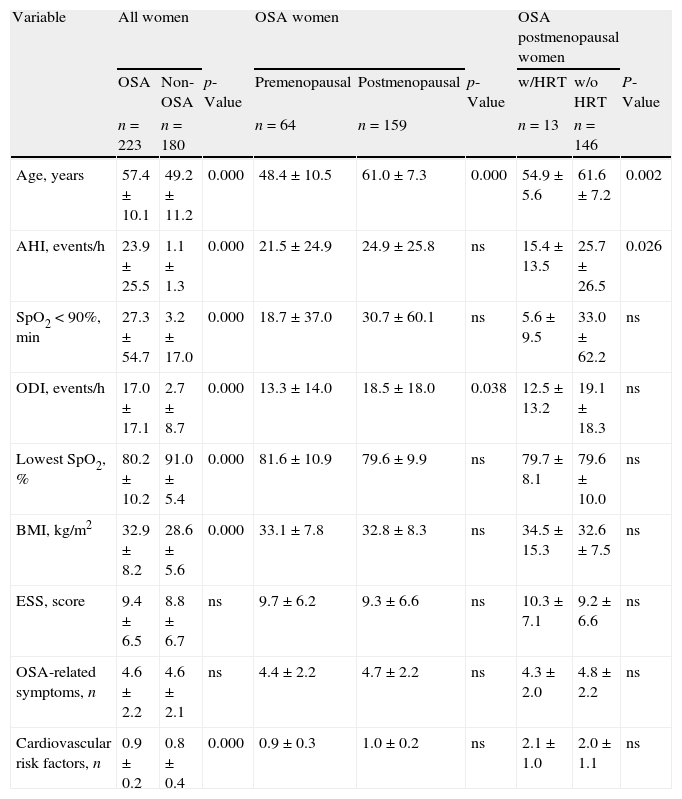Obstructive sleep apnea (OSA) is two to five times more prevalent in men than women but this gender-related difference is attenuated after menopause.1–4 Many of the hypotheses that explain the gender differences in OSA are based on the hormonal dissimilarities between men and women and the protective effect of circulating progesterone in women. So, one would expect that postmenopausal women with OSA would benefit from hormonal replacement therapy (HRT) but studies done so far are based on small series and still inconclusive.2,5
The aim of this study was to describe the prevalence, severity and risk factors for OSA in women, particularly menopause and HRT. We performed a retrospective analysis of women submitted to overnight polysomnography (PSG) at the Sleep Laboratory of Coimbra's University Hospital between 2004 and 2013. Clinical reports were reviewed and pertinent clinical data retrieved, including Body Mass Index (BMI), sleep-related complaints, comorbidities and previous medication. Menopausal status, according to the WHO classification, and other gynecological details were attained by a preset telephone questionnaire.
From a total of 745 consecutive female patients, 403 met the inclusion criteria of this study, 55.3% of which had OSA. Univariate analysis showed that OSA women were significantly older (p=0.000), had more frequent complaints of nycturia and dry mouth (p<0.025), more cardiovascular risk factors (p=0.000) and a higher risk for overweight/obesity, diabetes, arterial hypertension and dyslipidemia (p<0.032). Women without OSA had more daytime sleepiness (p=0.012), which could be explained by the higher risk for depression and/or anxiety (p=0.001). After menopause, women with OSA were older (p=0.000), had more frequent complaints of nycturia (p=0.000) and a two-to-fourfold higher risk for diabetes, dyslipidaemia and arterial hypertension (p<0.037) but had no significant polysomnographic differences compared to premenopausal women. AHI was significantly higher for postmenopausal women without HRT compared to those with HRT, but there where no relevant symptomatic differences between the two groups (Table 1). Multiple regression showed that age and BMI independently predicted OSA while depression and/or anxiety was negatively correlated with the risk of OSA. No significant association between OSA and menopause or HRT could be found in multivariate analysis adjusted for age.
Comparison of descriptive variables among women submitted to overnight polysomnography between January 2004 and December 2013.
| Variable | All women | OSA women | OSA postmenopausal women | ||||||
| OSA | Non-OSA | p-Value | Premenopausal | Postmenopausal | p-Value | w/HRT | w/o HRT | P-Value | |
| n=223 | n=180 | n=64 | n=159 | n=13 | n=146 | ||||
| Age, years | 57.4±10.1 | 49.2±11.2 | 0.000 | 48.4±10.5 | 61.0±7.3 | 0.000 | 54.9±5.6 | 61.6±7.2 | 0.002 |
| AHI, events/h | 23.9±25.5 | 1.1±1.3 | 0.000 | 21.5±24.9 | 24.9±25.8 | ns | 15.4±13.5 | 25.7±26.5 | 0.026 |
| SpO2<90%, min | 27.3±54.7 | 3.2±17.0 | 0.000 | 18.7±37.0 | 30.7±60.1 | ns | 5.6±9.5 | 33.0±62.2 | ns |
| ODI, events/h | 17.0±17.1 | 2.7±8.7 | 0.000 | 13.3±14.0 | 18.5±18.0 | 0.038 | 12.5±13.2 | 19.1±18.3 | ns |
| Lowest SpO2, % | 80.2±10.2 | 91.0±5.4 | 0.000 | 81.6±10.9 | 79.6±9.9 | ns | 79.7±8.1 | 79.6±10.0 | ns |
| BMI, kg/m2 | 32.9±8.2 | 28.6±5.6 | 0.000 | 33.1±7.8 | 32.8±8.3 | ns | 34.5±15.3 | 32.6±7.5 | ns |
| ESS, score | 9.4±6.5 | 8.8±6.7 | ns | 9.7±6.2 | 9.3±6.6 | ns | 10.3±7.1 | 9.2±6.6 | ns |
| OSA-related symptoms, n | 4.6±2.2 | 4.6±2.1 | ns | 4.4±2.2 | 4.7±2.2 | ns | 4.3±2.0 | 4.8±2.2 | ns |
| Cardiovascular risk factors, n | 0.9±0.2 | 0.8±0.4 | 0.000 | 0.9±0.3 | 1.0±0.2 | ns | 2.1±1.0 | 2.0±1.1 | ns |
OSA: obstructive sleep apnea; HRT: hormonal replacement therapy; w/: with; w/o: without; AHI: apnea–hypopnea index; SpO2: oxygen peripheral saturation; ODI: oxygen desaturation index; BMI: body mass index; ESS: Epworth sleepiness scale; ns: not significant. Values are displayed as mean±standard deviation.
In conclusion, age and BMI were the two main independent risk factors for OSA in women. Menopause was associated to OSA as part of the aging process itself, which has been corroborated by previous studies that showed a higher prevalence of OSA after menopause.2,3 HRT showed no benefits for decreasing the risk for OSA. Clinical presentation was similar between women with or without OSA.







